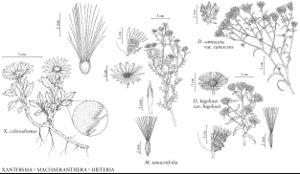Machaeranthera
Gen. Sp. Aster., 13, 224. 1832.
| Taxon | Illustrator ⠉ | |
|---|---|---|
 | Xanthisma coloradoense Machaeranthera tanacetifolia Dieteria bigelovii var. bigelovii Dieteria canescens var. canescens | Yevonn Wilson-Ramsey Bee F. Gunn Bee F. Gunn Bee F. Gunn |
Annuals or biennials, 5–100 cm; taprooted. Stems erect, much branched (when well developed), moderately to densely hairy, usually stipitate-glandular. Leaves basal (usually withering) and cauline; sessile; blades lanceolate to elliptic, pinnatifid, 2-pinnatifid, deeply lobed, or dissected (lobes aristate), ultimate margins entire, faces moderately to densely hairy, stipitate-glandular. Heads radiate, borne singly (on leafy peduncles 5–30 mm). Involucres broadly turbinate to hemispheric, (5–11 ×) 10–18 mm. Phyllaries 24–80 (–100) in 3–6 series, appressed, spreading, or reflexed, 1-nerved (flat to keeled), lanceolate to linear, unequal, bases ± indurate, apices herbaceous, margins not scarious, faces proximally glabrous, distally moderately to densely hairy, stipitate-glandular. Receptacles flat to convex, pitted, epaleate. Ray-florets 8–40 (–50), pistillate, fertile; corollas blue, violet, or purple. Disc-florets 14–160, bisexual, fertile; corollas yellow, tubes shorter than funnelform throats, lobes 5, erect, deltate to lanceolate; style-branch appendages lanceolate. Cypselae narrowly to broadly obovoid, slightly compressed, 8–18-ribbed, faces sparsely to densely hairy (hairs antrorse or appressed); pappi persistent, of 30–80 white to tawny, barbellate, apically attenuate bristles in 1–3 series. x = 4.
Distribution
w North America, n Mexico
Discussion
Species 2 (2 in the flora).
The relationships of Machaeranthera have long been unclear, and much disagreement has occurred about its circumscription. It has been included in Aster by some and maintained as a separate genus by others. In addition, all or parts of many other genera have been included in Machaeranthera by various authors, such as Xylorhiza, Dieteria, Arida, Xanthisma, Psilactis, and Rayjacksonia. Studies of chloroplast DNA and nuclear ribosomal DNA, in combination with chemical and cytological studies, do not support previous circumscriptions of Machaeranthera (D. R. Morgan and B. B. Simpson 1992; Morgan 1997, 2002). Those studies suggest that none of the other taxa are closest relatives of Machaeranthera, and they were treated as separate genera by Morgan and R. L. Hartman (2003).
Selected References
None.
Lower Taxa
Key
| 1 | Involucres hemispheric; phyllary apices spreading to reflexed; disc corolla lobes 0.3–0.7 mm, glabrous or glabrate | Machaeranthera tanacetifolia |
| 1 | Involucres broadly turbinate; phyllary apices appressed; disc corolla lobes 0.7–1 mm, hairy | Machaeranthera tagetina |
"[" is not declared as a valid unit of measurement for this property."]" is not declared as a valid unit of measurement for this property.